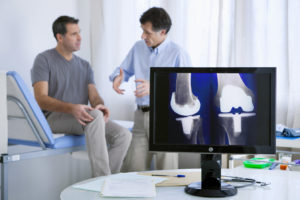Home » Blog » There’s Another Option to Knee Replacement Surgery
There’s Another Option to Knee Replacement Surgery

Your doctor says there are no other options. Your knee pain has gotten so bad that you can hardly walk. The medication and cortisone shots just aren’t cutting it anymore. It’s time for surgery.
No one wants surgery. Not only is going under the knife risky, but you’ll be facing months of healing to get back to where you are today. But you trust your doctor has your best interests at heart.
But before you do say yes to surgery, did you ever stop and think, what if there was an alternative?
The Ins and Outs of Knee Replacement Surgery
The purpose of replacement surgery is to relieve pain and restore function to the knee joint, damaged by arthritis. The American Academy of Orthopedic Surgeons states that more than 600,000 knee replacement procedures take place each year in the U.S., making it one of the most common surgeries in the country.
During surgery, the surgeon will replace the natural joint with an artificial joint, usually made of either plastic or metal. As with any surgical procedure, knee replacement carries the risk of complications. Risks include:
- Infections
- Blood clots
- Nerve damage
- Implant rejection
- Revision surgery (if something goes wrong)
Recovery time is yet another factor you need to consider. Once the surgery is complete, it can take approximately three to six months to fully recover. Typically, a patient may experience pain, swelling, and limited mobility during the recovery. Many patients also need rehabilitation and physical therapy to regain their strength, even after successful surgeries.
Modern knee implants are designed to be durable and long-lasting. However, what the doctors never tell you is that these artificial joints do wear down with time and overuse. And then you may need to have another, more complicated surgery to once again replace the knee.
How Do I Know If My Knee Replacement Is Failing?
There are a few signs to watch for to know when your knee replacement is failing, such as:
- Moderate pain becomes severe as time progresses
- You begin to experience symptoms of an infection, such as fever, chills, and muscle aches
- Mobility issues
- Excess fluid in the knee
- Warmth and redness of the skin around the knee
- A rash caused by metal hypersensitivity
- Bone destruction
- The tissue under the artificial joint has thickened
If any of these symptoms occur, you may have to undergo “revision” surgery. This surgery will remove the prosthesis and replace it with a new one. Another operation means another year of your life in recovery.
But you can avoid it.
How Platelet-Rich Plasma Therapy Can Help
For decades, platelet-rich plasma therapy (PRP) has helped relieve the pain caused by arthritis. Since it’s your blood, there’s little to no risk of an allergic reaction.
Here’s how it works:
Blood is drawn from the patient and is spun in a centrifuge at high speed to separate the blood into its four components: red blood cells, white blood cells, platelets, and plasma. Once separated, portions of the plasma are mixed back in with the platelets, forming a very “platelet-rich” solution. This solution is injected into and around the knee through the use of a Fluoroscope, significantly strengthening the body’s natural healing.
What Benefits Platelet Rich Plasma Therapy Offers
PRP therapy was approved 5-6 years ago in the U.S. Since then, it has become one of the most popular alternatives to knee replacement treatment in a relatively short time. Here’s why:
- Pain Relief: PRP injections can help relieve your chronic pain. The growth factors and bioactive proteins can help reduce inflammation, alleviating your knee pain. This treatment can also help in tissue repair, which can also help in pain management.
- Improved Mobility: With reduced chronic pain and potential tissue repair, knee movement may improve.
- Minimally Invasive: Unlike knee replacement, PRP therapy is minimally invasive. In most cases, your healthcare provider can do it in an outpatient setting. It requires only a simple blood draw and injection.
- Reduced Medication: PRP therapy can help alleviate your chronic pain, which may reduce the need for painkillers or anti-inflammatory drugs. It can help lower the risks associated with long-term pain medications.
- Lower Risk of Rejection: While knee replacement surgery can help, your body may reject the implant, forcing you to go for revision surgery. However, PRP therapy uses your own blood, which eliminates the chances of rejection response.
However, each person will respond differently to the PRP therapy. Some patients may experience sustained benefits lasting several months or even years. The question is – is PRP therapy right for you? Unlike knee replacement, this procedure is less invasive, painful, and expensive. Your knee will heal with minimal or no scarring. Beforehand, a competent healthcare professional will evaluate if the therapy is right for you.
We Have Other Options for Knee Replacement Treatment
Knee replacement surgery has long been a standard treatment for severe knee arthritis. Unfortunately, it comes with inherent risks, complications, and the potential need for revision surgeries. You will also spend several weeks to months in recovery after each surgery. That’s why you should consider alternatives to knee replacement, like platelet-rich plasma (PRP) therapy. It’s a minimally invasive approach with potential benefits, including pain relief, improved mobility, and reduced reliance on painkillers. Consulting with a healthcare provider can help you make an informed choice.
Before opting for knee replacement surgery, get all the options available. Contact Northeast Knee & Joint Institute today to schedule a no-risk, obligation-free consultation!
